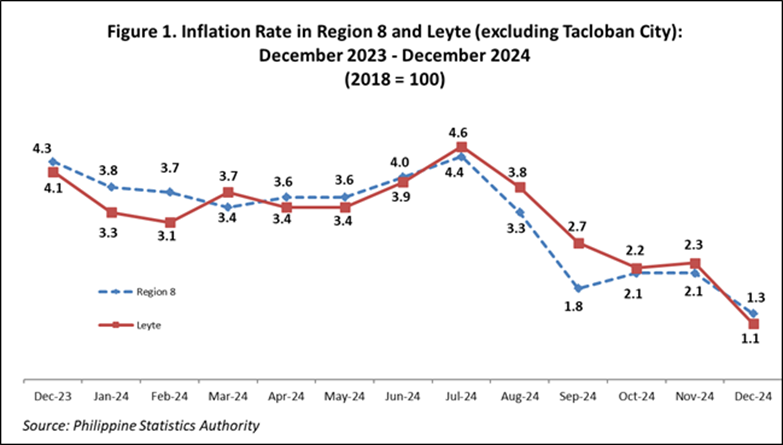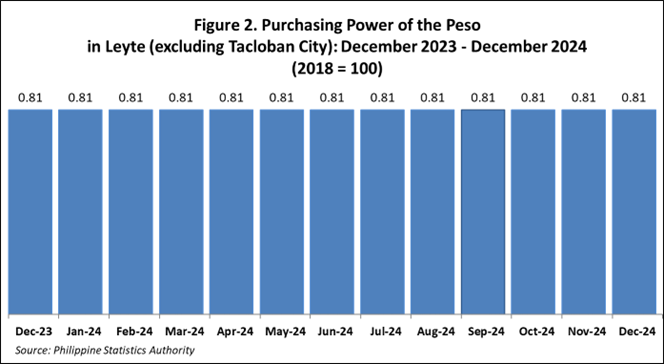Leyte’s inflation drops to 1.1 percent in December 2024

Leyte’s inflation rate slowed to 1.1 percent in December 2024, down from 2.1 percent in November 2024. This marks the lowest inflation rate recorded in the province for the year. The average inflation rate for Leyte from January to December 2024 stood at 3.1 percent. In December 2023, the inflation rate was higher at 4.1 percent. Similarly, the region’s inflation rate decreased to 1.3 percent in December 2024, down from 2.3 percent in the previous month, bringing the average inflation rate for the region from January to December 2024 to 3.1 percent. Among the provinces and highly urbanized city (HUC) in the region, Eastern Samar recorded an increase in its inflation rate in December 2024.
Main Drivers Contributing to the Downard Trend of Leyte’s Inflation
The downtrend in Leyte’s inflation rate in December 2024 was primarily driven by the slower annual increment of the heavily weighted food and non-alcoholic beverages, which dropped to 1.1 percent from 3.2 percent in the previous month. This slowdown was attributed to the slower rate of increase in prices of cereals and cereal products, milk, other dairy products and eggs, fruits and nuts, and water, as well as a decrease in the prices of fruit and vegetable juices. Additionally, lower annual increments were observed in the indices of the following commodity groups during the reference month:
a. Housing, water, electricity, gas and other fuels dropped to 1.6 percent from 3.0 percent in the previous month which was driven by the decrease in the prices of electricity;
b. Furnishings, household equipment and routine household maintenance decreased to 1.6 percent from 2.4 percent in the previous month due to the slower rate of increase in the prices of domestic services and household services;
c. Health slowed to 0.7 percent from 0.8 percent in the previous month which was caused by the slower rate of increase in the prices of medicines, inpatient curative and rehabilitative services, and diagnostic imaging services and medical laboratory services, as well as the decrease in the prices of medical products; and
d. Personal care, and miscellaneous goods and services decreased to 1.1 percent from 1.6 percent in the previous month which was driven by the slower rate of increase in the prices of other appliances, articles and products for personal care, hairdressing salons and personal grooming establishments, other personal effects, and other services, as well as the faster rate of decrease in the prices of jewelry and watches.
Moreover, clothing and footwear recorded a deflation of -0.7 percent, compared to -0.6 percent in the previous month. The deflation was driven by the slower rate of increase in the prices of cleaning, repair, and hire of footwear; the decrease in prices of clothing materials and other articles of clothing and clothing accessories; and the faster rate of decrease in the prices of garments.
In contrast, the following commodity groups recorded an increase in their respective inflation rates in December 2024:
a. Alcoholic beverages and tobacco went up at 2.2 percent from 1.4 percent in the previous month due to the faster rate of increase in the prices of spirits and liquors and tobacco, as well as the increase in the prices of wine;
b. Information and communication increased at 0.1 percent from zero percent in the previous month which was driven by faster rate of increase in the prices of mobile communication services;
c. Recreation, sport and culture went up at 1.5 percent from 1.3 percent in the previous month which was caused by the faster rate of increase in the prices of games, toys and hobbies and stationery and drawing materials; and
d. Restaurants and accommodation services increased at 0.1 percent from zero percent in the previous month due to the faster rate of increase in the prices of accommodation services.
In addition, transport recorded a deflation of -0.2 percent, compared to -2.2 percent in the previous month. This slower deflation was attributed to the slower rate of decrease in the prices of fuels and lubricants for personal transport equipment.
On the other hand, education services and financial services maintained their respective inflation rates in December 2024, at 12.6 percent and zero percent, respectively.
The top three commodity groups contributing to the trend of December 2024 inflation of Leyte were the following:
a. Food and non-alcoholic beverages with 75.6 percent share;
b. Housing, water, electricity, gas and other fuels with 20.1 percent share; and
c. Furnishings, household equipment and routine household maintenance with 2.1 percent share.
The inflation rate is the general rise in prices over a period. It indicates how fast or how slow price changes over two-time periods. Contrary to common knowledge, low inflation does not necessarily connote that prices are falling instead; it means that prices continue to increase at a slower rate. It is a derived indicator of the Consumer Price Index (CPI).
The CPI is a measure of change in the average retail prices of goods and services commonly purchased by a particular group of people in a specific area. The overall CPI in Leyte for December 2024 was 124.1. This implies that the average retail price of goods and services in Leyte is 24.1 percent higher than the average retail prices in 2018 (base year).

The Purchasing Power of Peso (PPP) in Leyte retained at 81 centavos in December 2024. Likewise, the PPP in the region retained at 80 centavos in December 2024. The 81 centavos purchasing power of peso in Leyte indicates that the same basket of goods and services worth 81 pesos in 2018 (base year) is worth 100 pesos during the reference period.//
SGD SHERYL ANN A. JAMISOLA
Chief Statistical Specialist

